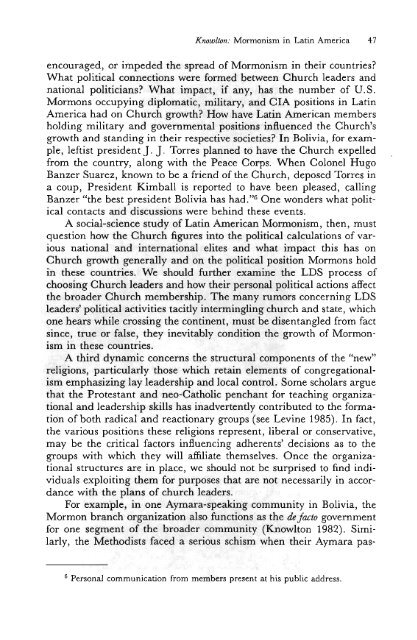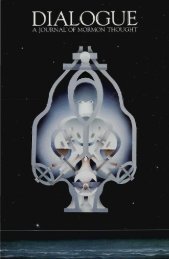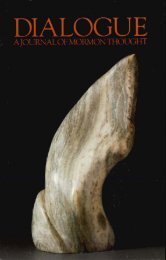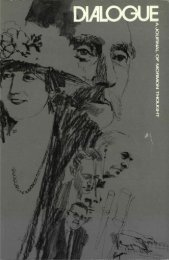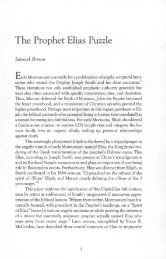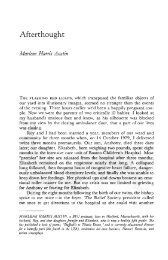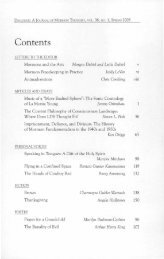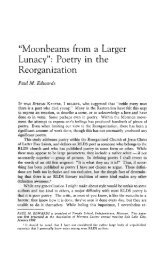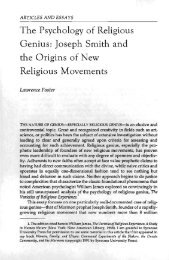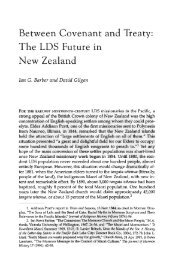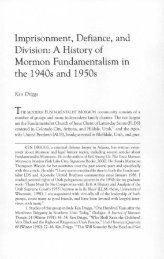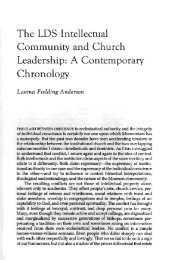Dialogue, Volume 25, Number 2 - Dialogue – A Journal of Mormon ...
Dialogue, Volume 25, Number 2 - Dialogue – A Journal of Mormon ...
Dialogue, Volume 25, Number 2 - Dialogue – A Journal of Mormon ...
Create successful ePaper yourself
Turn your PDF publications into a flip-book with our unique Google optimized e-Paper software.
Knowlton: <strong>Mormon</strong>ism in Latin America 47<br />
encouraged, or impeded the spread <strong>of</strong> <strong>Mormon</strong>ism in their countries?<br />
What political connections were formed between Church leaders and<br />
national politicians? What impact, if any, has the number <strong>of</strong> U.S.<br />
<strong>Mormon</strong>s occupying diplomatic, military, and CIA positions in Latin<br />
America had on Church growth? How have Latin American members<br />
holding military and governmental positions influenced the Church's<br />
growth and standing in their respective societies? In Bolivia, for example,<br />
leftist president J. J. Torres planned to have the Church expelled<br />
from the country, along with the Peace Corps. When Colonel Hugo<br />
Banzer Suarez, known to be a friend <strong>of</strong> the Church, deposed Torres in<br />
a coup, President Kimball is reported to have been pleased, calling<br />
Banzer "the best president Bolivia has had." 6 One wonders what political<br />
contacts and discussions were behind these events.<br />
A social-science study <strong>of</strong> Latin American <strong>Mormon</strong>ism, then, must<br />
question how the Church figures into the political calculations <strong>of</strong> various<br />
national and international elites and what impact this has on<br />
Church growth generally and on the political position <strong>Mormon</strong>s hold<br />
in these countries. We should further examine the LDS process <strong>of</strong><br />
choosing Church leaders and how their personal political actions affect<br />
the broader Church membership. The many rumors concerning LDS<br />
leaders' political activities tacitly intermingling church and state, which<br />
one hears while crossing the continent, must be disentangled from fact<br />
since, true or false, they inevitably condition the growth <strong>of</strong> <strong>Mormon</strong>ism<br />
in these countries.<br />
A third dynamic concerns the structural components <strong>of</strong> the "new"<br />
religions, particularly those which retain elements <strong>of</strong> congregationalism<br />
emphasizing lay leadership and local control. Some scholars argue<br />
that the Protestant and neo-Catholic penchant for teaching organizational<br />
and leadership skills has inadvertently contributed to the formation<br />
<strong>of</strong> both radical and reactionary groups (see Levine 1985). In fact,<br />
the various positions these religions represent, liberal or conservative,<br />
may be the critical factors influencing adherents' decisions as to the<br />
groups with which they will affiliate themselves. Once the organizational<br />
structures are in place, we should not be surprised to find individuals<br />
exploiting them for purposes that are not necessarily in accordance<br />
with the plans <strong>of</strong> church leaders.<br />
For example, in one Aymara-speaking community in Bolivia, the<br />
<strong>Mormon</strong> branch organization also functions as the de facto government<br />
for one segment <strong>of</strong> the broader community (Knowlton 1982). Similarly,<br />
the Methodists faced a serious schism when their Aymara pas-<br />
6 Personal communication from members present at his public address.


